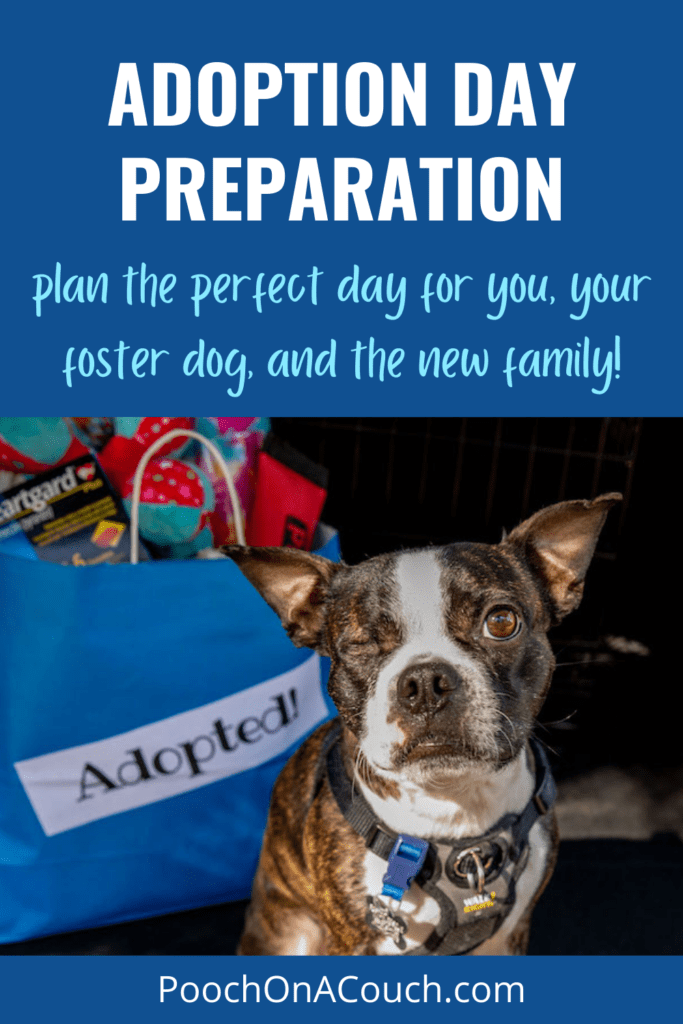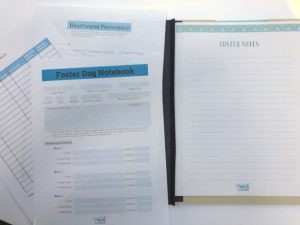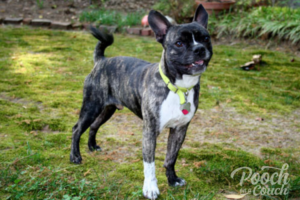Have you had the bittersweet experience of “adoption day”? The day you place your dog with the perfect match family, the carefully chosen family for your foster dog? The dog you’ve worked so hard to get ready for adoption?
I’ve prepared for many adoption days, and I experience the same emotions each and every time!
- Is my foster dog ready? Have I prepared them best I can for this day?
- Is this the right family? Why am I sure? What if?
- Am I sure I want to let this dog go to another family? Should I adopt this dog myself?
- And… My foster dog has been adopted for (12, 24, 48 hours) – are they doing OK? Struggling? Happy? Does the family already love them dearly? What if they don’t love him?
I can make myself nuts with self-doubt!
Adoption Day Preparation Helps Me, My Foster Dog, and The New Family
A tremendous amount of work is done before adoption day:
- the dog is rescued
- provided veterinary care
- recovered from any illnesses or injury
- settled in a foster home and assessed
- fosters teach the dog new skills & build confidence – the dog learns how to be a family pet
- applications are received and reviewed
- many conversations occur to process applications, obtain vet references, conduct interviews, and complete home checks.
- the family prepares to bring in a new pet.
- foster home prepares to transfer the pet.
- dog and family have a meet and greet.
- adoption contracts are drawn up and signed.
Adoption Day – It’s A Big Deal! Prepare For This Special Day
Prepare for adoption day with the same high standards. Seriously! Celebrate this HUGE achievement! Make the day a very big deal.
In contrast, your foster dog should think it’s no big deal at all.
How to Prepare Your Foster Dog for Adoption Day
People ask me this all the time:
- “Will my foster dog feel abandoned all over again when I leave them?”
- “Will they think I don’t love them?”
- “We worked so hard on (x behavior) – will they regress and have to start over?”
The answer is no, no and sometimes.
I’ve witnessed many a dog actually seem and appear proud that they have been adopted. There isn’t any science to prove this, but I’ve observed it and I personally believe it.
Will they be a bit confused about the change? A little bit. They are now living with people they don’t know, in a house that’s unfamiliar with new pets (maybe) that they have to get to know. But, the skills you taught them? The confidence they built while with you? That goes with them and helps them more quickly adjust to their new surroundings. It really does!
Sometimes a fearful dog may regress when moving to a new home, but if they’ve made progress in your home, it will benefit them in their new home.
Have a fearful foster dog? Read this!
The transition to the new is why you are going to write copious notes about how to help the family help your dog adjust to their new life.
Prepare Your Foster Dog For Adoption Day
How do I prepare my foster dog for adoption day?
Well, there’s no sit-down family meeting where I tell little foster pup “you need to be brave, you are going to live with a new family”! and we all cry. I mean, right? I’m being a little silly, but you get my point.
Very little of what you do to prepare your foster dog will involve your foster dog. If you are calm about it, they’ll only know something is up when you give them a bath!
Keep Your Daily Routine The Same
Keep your to-be-adopted dog’s routine the same. There is really no reason to change a thing. Unless there is a clear and specific reason why you need to alter your schedule to best help the dog transition to a new schedule, everything should remain SOP (standard operating procedure) at your home. Continue feeding at the same time and in the same manner, exercise and play as usual, sleep in the same place, you get the picture.
(Now – if you are a stay-at-home person and your foster dog is going to a home where they will be alone more – you should know this new setting will work. It’s why I am such a believer in crating your dog during the day even when you are home, and allowing your dog to practice being sans human. Alternately, ask the new family to take some vacation days to work on a smooth transition to a new daily schedule.)
Your foster dog will pick up the nuances of the new routine at their new home, just like they picked up on your routine at your home.
Check Your Emotions
Keep your emotions to yourself. That sounds a little mean, but hear me out: You definitely don’t want your emotions to stress out your foster dog.
If your foster dog experiences each day as a continuation of the day before, they will be calm and relaxed on adoption day. A calm, relaxed dog is going to transition into his new family and his new routine much easier than a stressed, confused dog.
In short, if you need to be emotional – and it really is ok to be emotional – find somewhere else to express it or express it in such a way that your foster dog does not feel stressed because of your sadness or worry.
Give Homework To Prepare New Owner For Adoption Day
Ask your soon-to-be adoptive family to start doing some homework. Give them a shopping list to purchase your foster dog’s favorite toys. Ask them to purchase the same type crate your foster dog is used to at your house.
Tell them about ID tags, harness, collar, leash. Discuss food: will they feed the same food you feed or switch brands? Do they use a special bowl? Having familiar supplies and equipment can help with your foster dog’s transition. c
How You Prepare Yourself for Adoption Day
Represent your rescue organization
Follow your organization’s guidelines and be their professional volunteer. If there are rules to follow, follow those rules even if you disagree.
I once lost a donor and future adopter because a volunteer foster didn’t agree with our agency’s rules and did her own thing on adoption day. Consequently, the adopter viewed the volunteer as an extension of the organization, and we were held accountable for that volunteer’s behavior and choices.
Gather information about your dog
Vet Records: The new family is going to want and need vet records to transition care to their personal vet. Who handles this? You? The rescue organization? When? How?
At a minimum, you should have in your hand a rabies certificate/tag and a health certificate where required by law. I personally review every vet record for my foster dogs – I’ve found the occasional honest omission that I was able to get corrected prior to adoption day. Once, a dog had not received a rabies vaccine! We fixed that error in a hurry!
If you know of an omission, speak to your rescue agency contact a.s.a.p. for instructions.
Write up your notes: What information about your foster dog do you want the new family to know? What is going to help them care for your foster dog as soon as they get it home? Your notes, your knowledge is so helpful to the family. Write it down, even if you covered everything in a phone call. I guarantee they didn’t remember every word. Your reference notes will be very helpful to the new family.
I include:
Basic Care Notes
- heartworm preventive – brand, dosage, and every date I’ve given a dose.
- my flea/tick preventive – brand or method and when I’ve given a dose.
- food – brand/formula, amount fed each day + frequency of meals. Special bowl needed? include that info!
- treats – type and how often
- exercise – type and how often
- medications/supplements, if any and when the next dose is due.
Personal Observations & Knowledge
- I list everything I know about the dog’s preferred and actual daily schedule. For example, if my foster dog prefers to poop before breakfast, I share that information with the family so my foster dog doesn’t have to work all over again to try and communicate its preferences or so the family doesn’t become unnecessarily worried over why their new dog isn’t eating their breakfast.
- Included in my notes is everything I’ve learned about the dog’s behavior, personality, quirks, preferences, fears, and what makes them full of joy. How do they eat? How do they play? What are they afraid of? Are they apprehensive around certain people? Other pets?
- I want the family to know what my dog knows – namely, what training they’ve received, the cues they know and which rewards are most motivating. Communication is the gateway to relationship building, help the new family communicate with their new pet!
- I list anything unique I discover. For example, one foster dog insisted her crate be positioned where she could see the back door.
- Write down all safety concerns. For instance, my current foster, Carter, likes to chase bees. His notes will include this tidbit of information along with recommendations to supervise him outdoors, keep Benedryl in the first aid kit, and keep the after-hours veterinarian contact info on the refrigerator. Do you have a door darter? Write that down!
Use a gift/tote bag to fill and give to the new family
This doesn’t have to be a big deal, nor does it need to be anything fancy or expensive. I go to the dollar store and purchase a paper gift bag, solid color, maybe one that coordinates with the brand color(s) of the rescue. Or – I might buy a plain white bag or brown paper bag, print out the rescue logo and glue it to the bag. You could even dress up a plain bag with markers: ADOPTED! or something like that. Simple, really, but it delivers a message: This is a special day for an amazing dog.

In the tote bag, I include:
- All paperwork, in a folder
- Any medications are packed. Dosing instructions are in the paperwork.
- Enough food and treats for one week – allows for a smooth transition to a new food if needed. (if the new family is going to use the exact same food you are using, you don’t have to include food. Otherwise,don’t skip this step – do you want your foster dog to have diarrhea in the first days in their new home? I know you don’t!)
- I include a familiar blanket and a favorite toy from the community toy box. My foster dogs usually have a favorite. Familiar smells and object will aid in the transition.
- I give either one complimentary heartworm preventive dose or a written prescription from the veterinarian so the family has no barriers to keeping the foster dog on a preventive dosing schedule. Missing even a few days with heartworm preventive dosing is too risky. Help the family stay on schedule!
- I also usually have an extra gift – favorite toys, treats – things like that.
Prepare Your Foster Dog For Adoption Day
To your foster dog, it’s just another day.
I’ll say it again: Don’t shift routines. I don’t give extra attention, or more or less exercise, or more of this or less of that. I do stay the course with all of the manners goals and health goals I set for my foster and we practice going through our paces. Just like we do every day.
My intuitive foster dogs do know something’s up. You may have seen it: they sense a change in the air and react to a shift in energy. Some dogs become more clingy. Others forget their manners. They have a little increased activity or anxiety. I’m sure it’s something subtle in my behavior, energy, or mannerisms, as hard as I try to remain “normal.” It’s my cue to check myself, check my emotions, and stay the course.
It’s my job to do what I can to not make a big deal out of the subtleties, to go about the day-to-day as if nothing’s up. To react otherwise is to increase uncertainty in my foster dog.
I want a smooth transition. I want my foster dog as happy and relaxed and confident as possible when they meet their new family on adoption day! You do, too!
Ears, Nails, Anal Glands, Oh my!
I have a funny little story to tell:
Once, the president of the rescue organization picked up my foster dog – she was delivering Winston to his new home, a few states away. While traveling in the airtight car, Winston blew his anal glands.
The day before, I bathed him, brushed him, trimmed his nails, and cleaned his ears. I totally forgot to think about anal glands.
I heard about that stinky car ride for months!
Is Your Foster Dog Awesome And Special? Why, YES!!
Prepare your dog for adoption day! Is this a special day? A special dog? Is this a special family? Yes is your answer, hopefully! Present a very clean, groomed and well cared for dog. To me, nothing says neglect like horribly long toenails and gooey ears. Seek the assistance of a professional, skilled groomer if you need in order to get those nails trimmed. I know not every dog likes their toenails touched. But in fact, long toenails are painful to your dog.
- bathe, but skip the perfume afterwards
- clean the ears
- trim coat if needed
- trim nails
- have anal glands expressed
Prepare the New Family For Adoption Day
Provide An Adoption Manual
Provide the new family with an adoption manual. I hope your rescue organization has one. This manual will have some general guidelines on how to help bring a new dog into the household, what risks to avoid, how to introduce the dog to anything new, and other information related to providing a less stressed transition and years of joy with their new pet.
Give The Family an Adoption Supply Shopping List
The family is going to need to buy dog adoption supplies before they come pick up their dog. Give them a shopping list!
The worst place to take your dog right after you adopt is the pet store. I mean – it is probably one of the most stressful places for a dog on the planet, second only to a dog park. If everything is already purchased, at home and set up, you can take your pup home immediately, and it can begin to settle in the new environment.
Let Them Know The ‘What If’ Instructions
Are you available for follow-up if the family has questions? Will you check in with them? Can they call or text you? Follow the guidelines of your rescue organization, but the family should have access to a representative if there is a question or situation that arises. They view you and your organization as professionals and specialists in the animal care field.
Sometimes a family needs a recommendation for a product or where to find a good veterinary specialist. Likewise, they may want to reach out to share their joy with someone who knows and loves their dog as they do. Let them know what they should do if they have a need.
Preparation helps ensure your foster dog has a smooth transition and equips the new family with many tools to help their new dog settle in quickly. Honestly, it helps me prepare to let them go. Somehow, as I write my notes, gather information, and organize the gift bag, I’m able to process all of my self-doubts, my sadness, my nagging “what if” questions as I move through the paces of preparing my awesome foster dog to meet their awesome, perfect family.
What helps you prepare to let your foster dog go? How do you present your foster dog to their new family? Share your ideas with us!

Popular Posts
- HOW TO CHOOSE A DOG RESCUE AGENCY
- ULTIMATE GUIDE TO FOSTERING: 10 SKILLS YOU NEED
- VOLUNTEER IF YOU CANNOT FOSTER





I always worry that my foster dogs will feel abandoned again when they go to their new home. I know it is more my mind set then my foster dog’s but definitely can’t help but wonder.
I remember Emmy Lou’s adoption day. I was worried – she’d been with me for two years, was deaf and had separation anxiety. We’d made tremendous progress. Would she totally regress? I met the new family, perfect for her, and stayed for about an hour letting Emmy Lou get to know them. She ignored me most of the hour, enjoyed their affection, watched intently as they signed words to her, played a gentle game of tug with a toy. Eventually, she walked over to me, put both paws on my knees, and looked me dead in the eye – I truly believe she said, “I love you but I have to go now.” and with that, she turned around and went across the room to her new family. I’ll never forget that moment! She knew, and she was completely OK with it.